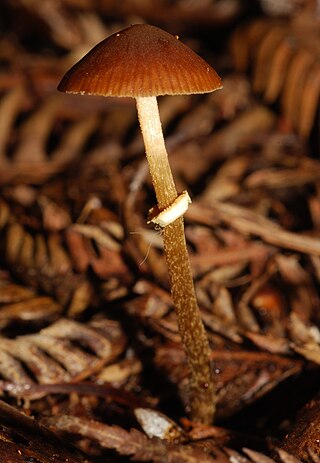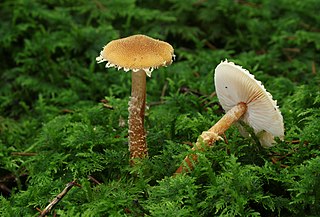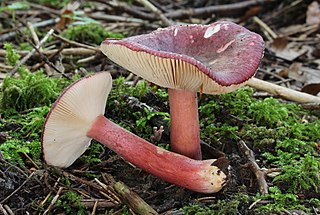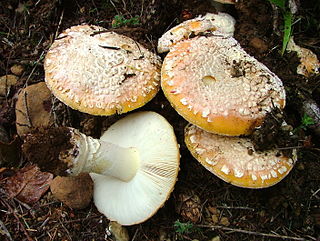
Lepiota is a genus of gilled mushrooms in the family Agaricaceae. All Lepiota species are ground-dwelling saprotrophs with a preference for rich, calcareous soils. Basidiocarps are agaricoid with whitish spores, typically with scaly caps and a ring on the stipe. Around 400 species of Lepiota are currently recognized worldwide. Many species are poisonous, some lethally so.

Amanita calyptroderma also known as coccora, coccoli or the Pacific amanita, is a white-spored mushroom that fruits naturally in the Sierra Nevada mountains and coastal forests of the western United States during the fall, winter and spring.

Tricholomopsis rutilans, commonly known as plums and custard, or red-haired agaric, is a species of gilled mushroom found across Europe and North America.

Conocybe rugosa is a common species of mushroom that is widely distributed and especially common in the Pacific Northwest of the United States. It grows in woodchips, flowerbeds and compost. It has been found in Europe, Asia and North America. It contains the same mycotoxins as the death cap mushroom. Conocybe rugosa was originally described in the genus Pholiotina, and its morphology and a 2013 molecular phylogenetics study supported its continued classification there.

Lepiota brunneoincarnata, the deadly dapperling, is a gilled mushroom of the genus Lepiota in the order Agaricales. Widely distributed in Europe and temperate regions of Asia as far east as China, it grows in grassy areas such as fields, parks and gardens, and is often mistaken for edible mushrooms. The mushroom has a brown scaled cap up to 4 cm wide with a pinkish brown stem and white gills. It is highly toxic, with several deaths having been recorded as it resembles the edible grey knight and fairy ring champignon.

Echinoderma asperum or Lepiota aspera, sometimes known commonly as the freckled dapperling, is a large, brownish, white-gilled mushroom, with a warty or scaly cap. It lives in woodland, or on bark chips in parks, and gardens.

Cystoderma amianthinum, commonly called the common powdercap, saffron parasol, the saffron powder-cap, or the earthy powder-cap, is a small orange-ochre, or yellowish-brown, gilled mushroom. It grows in damp mossy grassland, in coniferous forest clearings, or on wooded heaths. It is probably the most common of the small genus Cystoderma. It is not recommended for consumption due to its resemblance to poisonous species.

Leucoagaricus leucothites, commonly known as the smooth parasol, woman on motorcycle, ma'am on motorcycle, white dapperling, or white agaricus mushroom, is a species of agaric fungus. The species was originally described as Agaricus leucothites by Carlo Vittadini in 1835, and bears similarity to species of that genus. Solomon Wasser transferred it to Leucoagaricus in 1977. While sometimes regarded as edible, the species is suspected of being poisonous due to gastric-upset-causing toxins. It could also be confused with the deadly Amanita ocreata.

Mycena haematopus, commonly known as the bleeding fairy helmet, the burgundydrop bonnet, or the bleeding Mycena, is a species of fungus in the family Mycenaceae, of the order Agaricales. It is widespread and common in Europe and North America, and has also been collected in old Japan and Venezuela. It is saprotrophic—meaning that it obtains nutrients by consuming decomposing organic matter—and the fruit bodies appear in small groups or clusters on the decaying logs, trunks, and stumps of deciduous trees, particularly beech. The fungus, first described scientifically in 1799, is classified in the section Lactipedes of the genus Mycena, along with other species that produce a milky or colored latex.

Leucopaxillus albissimus, commonly known as the large white leucopaxillus, is a species of mushroom that lives as a saprobe, decaying the litter under coniferous trees. It produces a large white fruiting body that is unusually resistant to decay. It is considered to be inedible.

Lepiota castanea, commonly known as the chestnut dapperling or petite parasol, is a deadly poisonous, uncommon, gilled mushroom of the genus Lepiota in the order Agaricales. It is known to contain amatoxins and consuming this fungus can be a potentially lethal proposition. It was described by French mycologist Lucien Quélet in 1881.

Russula queletii otherwise known as the gooseberry russula, is a common, inedible, Russula mushroom found growing in groups, predominantly in spruce forest. Eating this mushroom causes abdominal pains.

Lepiota clypeolaria, commonly known as the shield dapperling or the shaggy-stalked Lepiota, is a common mushroom in the genus Lepiota. It is widely distributed in northern temperate zones, where it grows in deciduous and coniferous forest. Fruit bodies have a brownish cap, a shaggy stipe with a collapsed, sheathing ring or ring zone, and spindle-shaped spores.

Hygrophorus goetzii is a species of fungus in the family Hygrophoraceae. It is a snowbank mushroom with a rosy-pink cap that fades to cream color in maturity.

Leucocoprinus brebissonii is a species of mushroom producing fungus in the family Agaricaceae. It is commonly called the skullcap dapperling due to its distinctive pattern on the cap. This mushroom was only thought to be found in Europe but it has since been observed in the Pacific Northwest and may also be found in Asia.

Amanita aprica, also known as the sunshine amanita, is a toxic species of fungus in the family Amanitaceae.

Lepiota castaneidisca is a species of agaric fungus in the family Agaricaceae. Formally described in 1912, it was for a long time considered the same species as the similar Lepiota cristata until molecular analysis reported in 2001 demonstrated that it was genetically distinct. It is most common in coastal and northern California, and has also been recorded in Mexico. A saprobic species, it is usually found under redwood and Monterey cypress. Its fruit bodies (mushrooms) have white caps with an orange-red to orange-brown center that measure up to 3.2 cm (1.3 in) wide. The cream-colored to light pink stems are up to 6.5 cm (2.6 in) long by 0.2–0.6 cm (0.1–0.2 in) thick, and have a ring. L. castaneidisca can be distinguished from other similar Lepiota species by differences in habitat, macroscopic, or microscopic characteristics.

Lepiota cristata, commonly known as the stinking dapperling, brown-eyed parasol, or the stinking parasol, is an agaric and possibly poisonous mushroom in the family Agaricaceae. A common and widespread species—one of the most widespread fungi in the genus Lepiota—it has been reported from Europe, northern Asia, North America, and New Zealand. It fruits on the ground in disturbed areas, such as lawns, path and road edges, parks, and gardens. The species produces fruit bodies characterized by the flat, reddish-brown concentric scales on the caps, and an unpleasant odour resembling burnt rubber. Similar Lepiota species can sometimes be distinguished from L. cristata by differences in cap colour, stipe structure, or odour, although some species can only be reliably distinguished through the use of microscopy.

Lepiota brunneolilacea, also known as the star dapperling, is a gilled mushroom of the genus Lepiota in the order Agaricales. It is known to contain deadly amounts of alpha-Amanitin, and was responsible for a fatal poisoning.
Leucocoprinus cygneus is a species of mushroom producing fungus in the family Agaricaceae.



















